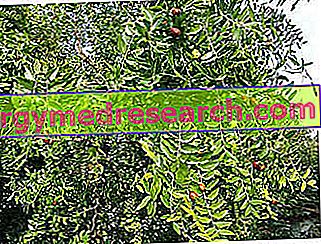REFINAH ® is a drug based on Rifampicin + Isoniazid
THERAPEUTIC GROUP: Antimycobacterials - Association of drugs for the treatment of tuberculosis
IndicationsAction mechanismStudies and clinical effectiveness Usage and dosage instructionsWarnings Pregnancy and lactationInteractionsContraindicationsUndesirable effects
Indications RIFINAH ® Rifampicin + Isoniazid
REFINAH ® is indicated in the treatment of pulmonary and extrapulmonary tuberculosis sustained by microorganisms sensitive to Rifampicin and Isoniazid.
Mechanism of action RIFINAH ® Rifampicin + Isoniazid
RIFINAH ® owes its great therapeutic efficacy to the association of two active ingredients with marked antibacterial and anti-mycobacterial activity.
In fact Rifampicin is an antibiotic belonging to the Rifamycins category, endowed with a wide spectrum of active action both against Gram positive organisms and Gram negative, aerobic and anaerobic organisms.
However, the aforementioned active principle is also characterized by direct bacteriostatic action against mycobacteria, which can easily penetrate eukaryotic cell membranes and selectively inhibit bacterial dependent DNA RNA polymerase, thus exerting a control activity against the proliferative phase of intracellular microorganisms.
The second active ingredient, namely? ™ Isoniazid, owes instead its antimycobacterial activity, after metabolization by bacterial enzymes, to the ability to inhibit the synthesis of mycolic acids, essential components of the cell wall of the mycobacteria.
All this translates into a bactericidal activity for rapidly growing microorganisms, in a bacteriostatic for those with slow growth rates.
Studies carried out and clinical efficacy
COMPARISON OF STRAIN-RESISTANT STRAINS WITH REFAMPICINE / ISONIAZIDE
Work that demonstrates how the indiscriminate and inappropriate use of Rifampicin and Isoniazid has led to the onset of mutations in mycobacteria capable of conferring innate resistance to drug therapy.
THE GREAT EFFICACY OF RIFAMPICIN IN THE TREATMENT OF TUBERCULOSIS
A study that shows how, despite the formulation of new active ingredients with mycobactericidal activity, Rifampicin is still one of the most effective and therefore most used drugs in the treatment of tuberculosis.
ISONIAZIDE AND REFAMPICINE: side effects
Case report demonstrating how excessive dosages of Rifampicin and Isoniazid can induce severe side effects such as lactic acidosis, renal and hepatic failure, convulsions and haematological disorders such in some cases as to cause patient death.
Method of use and dosage
RIFINAH ®
Tablets coated with 300 mg of Rifampicin and 150 mg of Isoniazid.
Although medical supervision is fundamental both for the definition of the therapeutic dosage and for the monitoring of the therapeutic procedure, usually the intake of one tablet twice a day, preferably before the main meals, would be the most used and the most effective in adult patients.
Warnings RIFINAH ® Rifampicin + Isoniazid
Treatment with RIFINAH ® must necessarily be preceded by a careful medical examination, aimed at assessing the prescription appropriateness, the possible presence of contraindications and above all the physiopathological status of the patient.
Despite the initial visit, it is necessary for the physician to monitor the patient's state of health during the whole therapeutic process, paying particular attention to the evaluation of markers of liver function, given the ability of both active ingredients to seriously compromise the? functional and structural integrity of this organ.
In this regard the patient should avoid the possible contextual intake of drugs, active ingredients or substances with hepatotoxic potential, taking care to warn his doctor following the appearance of any sign or symptom of an adverse drug reaction.
Elderly or malnourished patients should take vitamin B6 at the same time as RIFINAH ® therapy.
PREGNANCY AND BREASTFEEDING
In light of the various studies published in the literature that demonstrate the potential toxic and teratogenic effects of both active ingredients for fetal health, it would be advisable to avoid the intake of RIFINAH ® during pregnancy.
This contraindication should also be extended to the subsequent breastfeeding phase given the ability of the active ingredients to easily pass through the mammary filter, thus concentrating in breast milk at pharmacologically active doses.
Interactions
The intense hepatic metabolism to which both active ingredients of RIFINAH ® are subjected exposes the patient in therapy to the risk of particularly serious drug interactions.
For this reason it would be important for the patient receiving RIFINAH ® to avoid the simultaneous intake of drugs metabolised by the same liver enzymes such as oral contraceptives, methadone, anticoagulants, psychotropic drugs, estrogens, antihypertensives, anticonvulsants etc.
It is also important to consider how the ability of? Isoniazid to inhibit enzymes such as monoamine oxidases, could determine alterations in the metabolism of tyramine and? ™ histamine, inducing adverse reactions to foods containing the aforementioned elements.
Contraindications RIFINAH ® Rifampicin + Isoniazid
- The use of REFINAH ® is contraindicated in patients who are hypersensitive to the active ingredients or to one of its excipients and in patients suffering from severe liver diseases.
Undesirable effects - Side effects
The active ingredients contained in RIFINAH ® could determine the appearance of different side effects, among which the most frequent are clinically:
- Itching, skin rash and different hypersensitivity reactions;
- Gastrointestinal disorders such as nausea, abdominal pain, anorexia and hepatitis;
- Immunological disorders with eosinophilia, leukopenia, thrombocytopathies and myopathies.
Note
REFINAH ® is a prescription-only drug.



